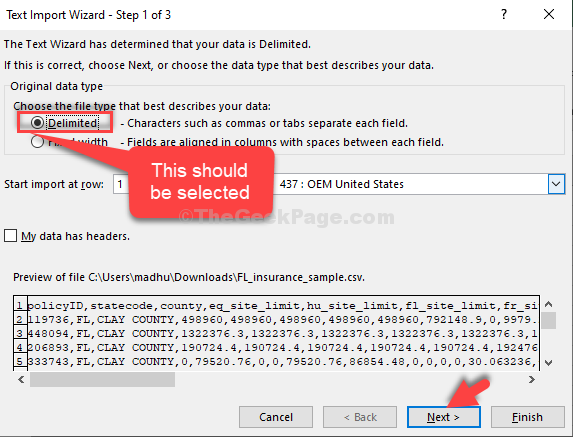
Click Next when you’re happy with the settings.
#Excel text import wizard data header windows#
In this example I have selected to import a delimited file and set the file origin to Windows (ANSI). Step 1 of the Text Import Wizard, define file type The screenshots shown here may look slightly different from yours, but the principle is the same.Ĭlick the Open button. This section applies to all Excel versions as of Excel XP (and maybe even older). Now it is time to define what settings we need for the import. Select data source dialog, selecting a file In this dialog, choose the “Text files” option and then navigate to your file: The select data source dialog of Excel 2003, selecting source type (you can skip the next section about Excel 2003 and older and continue with All versions: defining the import settings)įrom the menu, select Data, Get External Data, Import Data. The “From Text” button, located on the Data tab of the ribbonĬlick Import. On the ribbon, click the data tab and then click the “From Text” button on the “Get External data” group. Note that the following steps differ for the various Excel versions. How do you import the data from those files into the same worksheet each time, without having to re-define the import settings over and over again?įirst select the sheet where your data needs to appear. What if you have the situation where you get files with similar structure, which need the same text import settings over and over? The Text import wizard does not start for these file types. If you have ever opened a CSV file, you have probably noted you can’t set up how it gets imported. If you’ve ever tried to open a text file, you have probably used the Text import wizard. csv files into an existing sheet in Excel.
#Excel text import wizard data header how to#
In this article, I’ll explain how to ease importing of. You can find more useful tips from Jan Karel on his website. Select the one used in your file.Today’s author is Jan Karel Pieterse, an Excel MVP, who describes the process of importing text in great detail. The coordinates are in The Text Import Wizard can import coordinates in a number of standard forms. Will use those settings to import this file.Ĭoordinate Format Select the coordinate format used in this text file.


If this text file uses the same layout as a file you previously imported, select the proper layout and the Text Import Wizard The Text Import Wizard has determined that your file does not have a header row (because empty fields exist in row 1). If your data has the names of the columns at the top of the file, check Has Header Row. One of these files, ExpertGPS will automatically recognize the file's header row and fill out the Text Import Wizard forĭelimiter Select the character that separates columns of data in your file. Once you have defined the settings forĪ particular data format in the Text Import Wizard, you can save these settings (in Step 3). You may work with several standard data formats in the course of your job. Make for the delimiter, header row, and coordinate format. The list at the bottom of the dialog displays a preview of the text data, and will change to reflect the choices you Used to separate columns of data (comma, tab, etc) and specify the type of coordinates used in the text file. In the first step, you choose the character The Import Text Wizard allows you to import delimited text files (CSV, tab-delimited, etc) from a spreadsheet or


 0 kommentar(er)
0 kommentar(er)
